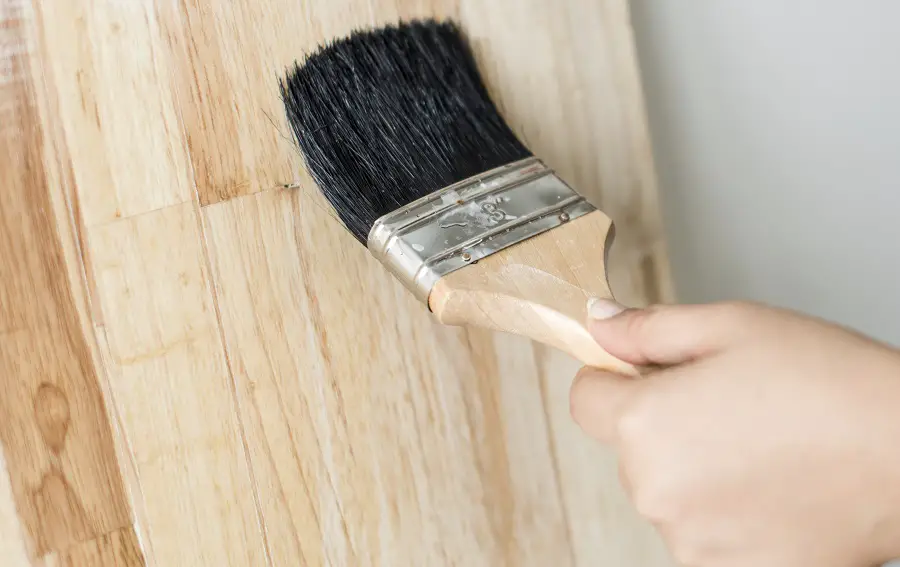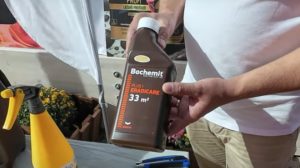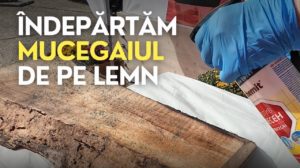Even if the theme Sibiu meeting with carpenters there was socializing, many technical topics were also discussed, and some of them were related to the finishing of wood and derived panels. Someone brought up the use of aracite solution in the sanding process. It was the starting point for a debate about the purpose of using aracite solution, pros and cons, and professional materials with which to achieve similar results. It sounds like a topic of interest to carpenters and wood enthusiasts, so I am reprinting it below.

Why and how to use a solution of aracheth
The main purpose of using aracet is blocking the absorption of the berry deep into the wood, which makes more uniform coloration. It was a method widely used in factories in the past, especially those that made doors with profiled doors or profiled furniture. In the profiled areas, on the battens as they used to say in the old days, there are a lot of fiber ends, the color absorption in the wood is very high and the area is darkened a lot compared to the rest of the furniture. The aracite solution is absorbed into the wood, the adhesive molecules (PVA - polyvinyl acetate) end up in the wood where they harden. This forms a barrier in the wood which prevents deep absorption and the color remains only in the surface area of the wood.
The solution is also used as a sealer for milled MDF or tanned wood. However, it is not the best solution because the aracite is not very water resistant. If water-based products are applied, there is no guarantee that the tannins will not come out of the wood or that a large amount of paint will not be absorbed into the milled area.
There are many who believe that the glue solution is used to improve the sanding because the wood grain lifts after application. This is actually a side effect. Being a water-based solution, the absorption into the wood is high and the grain rises. Sanding is thus easier, the uniformity of coloration and the subsequent adhesion of the coatings (primer/lacquer/paint) is better. But the same effect is obtained if wet sanding, i.e. before sanding the surface is wiped with a cloth dampened with water without grit.
The aracite solution is obtained by mixing 1 part aracite with 3 or 4 parts water (concentration 20-25%). Use ordinary aracite, not hardening (mono or bicomponent). Apply the solution by brush, sponge, cloth or spray. After application, allow the wood to dry for 2-5 hours, depending on shop conditions. It is a water-based solution so room temperature and air circulation are important. After drying, the wood is sanded and the stain or paint is applied.
The pros and cons
Arguments in favor of using aracite solution are its low price, ease of application, lack of solvents (volatile organic compounds VOCs), a formaldehyde and other hazardous substances. It's a handy solution, especially for do-it-yourselfers, but also for carpenters who are just starting out in wood finishing.
However, as it is a product made for a completely different use - gluing wood - the behavior over time can be unpredictable, especially when it comes to sealing (isolating) tannin in wood, knots and MDF. Care must be taken when dosing as too much aracite in water can lead to a film that reduces the adhesion of subsequent coats to the wood/MDF.
Liviu C., a specialist in abrasives, draws attention (in his comments) to a phenomenon that can occur when mechanically sanding panels to which an aracite solution has been applied: "Cracking can lead to blackening of the wood when sanding. This phenomenon generally occurs, as an example, when sizing jointed panels where there is a surplus of uncured adhesive at the time of joining. This surplus of adhesive/sanding generates a burning phenomenon on the surface of the wood and on the sanding belt. In manual sanding it may not occur, but where the sanding is mechanized, due to the working speed of the abrasive, this phenomenon appears."
Alternative
Sthe hellac and insulators are safer alternatives for sealing wood and regulating absorption. Shellac is a very good alternative for isolating knots or wood so that tannin does not escape to the surface. It is frequently used by modeling, inlay and marquetry enthusiasts because it does its job very well, and after drying (removal of alcohol from the varnish solution) the wood can be finished with oil or any varnish.
When producing wooden or MDF furniture for commercialization, my recommendation is to use professional insulators. Any company that sells professional wood varnishes and paints has such products in its portfolio. Using them as directed eliminates the risk of subsequent defects.
There are also alternatives to using a solution of aracite to achieve a uniform color. A handy alternative is to apply a thin first coat of thinned primer and then apply the stain. Use the primer to be applied to obtain the film and dilute it at least 1:1. No film must form when applying it. After drying, sand it and apply the primer. Another option is to use colored varnishes. The disadvantage here is the less natural, plastic-like appearance. The professional option is to use even varnishes that are made in such a way that they do not go deep into the wood. This way no stains appear or stand out wood growth defects.
I hope you find the above information useful. As always, additions are welcome. And if you have any questions or queries, please leave them below in the space provided. I will be sure to reply.




































Hello, please bear in mind when recommending these methods that the use of aracite can lead to blackening of the wood when sanding. This phenomenon generally occurs, as an example, when sizing jointed panels where there is a surplus of uncured adhesive at the time of joining. This surplus of adhesive/sandpaper generates a burning phenomenon on the grading machine, both on the surface of the wood and on the sanding belt. When sanding by hand it may not occur, but where the sanding is mechanized due to the working speed of the abrasive, this phenomenon occurs. As you said and I quote "Shellac and insulators are the safer alternatives for sealing the wood and regulating absorption".
Hello!
Thanks for the addition. I will add the recommendation to the article.
Hello Mrs Mihaela, what can you tell me about Bios Wood total solution for wood treatment.
Hello!
I have not worked with this product. From what I have read I understand that it is a natural product that stabilizes the wood while protecting it from insect and fungal attack.
The product is a mixture of cedar oil and silicon salts. The cedar oil is the one with insect-fungal properties, the silica salts provide wood stabilisation.
It is a product that prevents fungal and insect attack, not treats it.
About the qualities of cedar oil and the treatment of wood with sodium silicate (glass water), you can also find information in the articles below.
All the best!
https://revistadinlemn.ro/2017/06/09/ce-este-si-la-ce-se-foloseste-uleiul-din-lemn-de-cedru/
https://revistadinlemn.ro/2017/06/02/tratarea-lemnului-cu-silicat-de-sodiu/